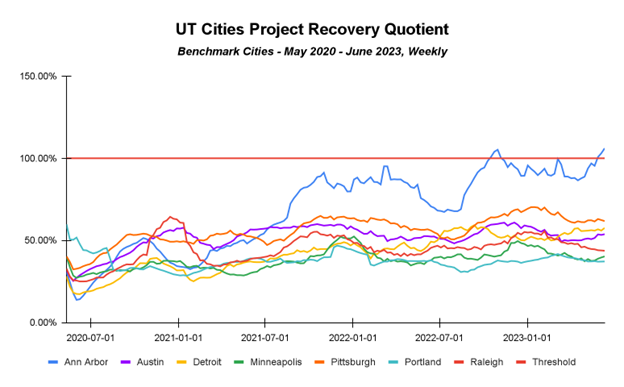
For the past few years, Ann Arbor SPARK has worked closely with the Quantitative Methods in the Social Sciences (QMSS) program at the University of Michigan to explore research topics related to economic development. As an interdisciplinary minor, the program merges data science with social science, equipping students to analyze complex data and translate it into meaningful insights.
For our most recent project with the QMSS program, we asked the students to delve into the topic of Ann Arbor’s downtown space use and recovery, post-pandemic.
This year, four student teams were formed, led by Dr. Beth Ann Whitaker. Focus areas for the teams included:
- Commuting Trends/Transit in and Around Ann Arbor
- Commercial Space Utilization, Cost, and Availability
- Coworking Spaces and Remote Work
- Downtown Recovery Quotient (University of Toronto Partnership)
We learned several things through this work:
Ann Arbor’s Downtown Activity Surpasses Peer Cities
Ann Arbor’s downtown recovery has not only returned to pre-pandemic levels, but it has outpaced that of communities we are typically stacked up against, including Austin, Detroit, Minneapolis, Pittsburgh, Portland, and Raleigh:

Earlier this year, the University of Toronto released research which showed how activity in various cities in North America had – or had not – recovered since the pandemic. After the report was released, we could not help but wonder how Ann Arbor’s recovery compared to others across the nation. Students in the QMSS program were able to update data through the University of Toronto’s work to include Ann Arbor as well, which is included in the graph above.
Activity & Commuting Patterns Look Different Now
Despite an active downtown, the shift to remote work was noted across all teams as a considerable influence on what downtown space use looks like now in Ann Arbor:
- According to a commuter and employer survey conducted by TheRide, there has been a significant decline in daily commuting to Ann Arbor from 2018 to 2023, with a marked increase in remote work.
- Michigan State University’s State of the State Survey shows that Washtenaw County has the largest percentage of workers who can work remotely.
- Google’s mobility data shows that workplaces in Washtenaw County have not returned to pre-pandemic levels of weekday activity, due to the higher concentration of jobs that can be performed remotely.
Other Lessons & Some Implications
Compared to other cities across the nation, Ann Arbor is affordable; however, it is the most expensive housing market in Michigan. With remote work here to stay, our region could be vulnerable to younger workers pursuing remote opportunities from communities that offer a lower cost of living than Ann Arbor. This notion is supported by findings from the Michigan State University State of the State Survey. Lower cost of living is cited as the biggest motivating factor for why individuals would choose to move if remote work were a choice:

Adapting to the shift towards hybrid work is crucial. This involves reassessing the use of commercial spaces and supporting coworking initiatives to ensure that both hybrid workers and remote companies receive strong community support. Creating a vibrant downtown may vary from one community to another but concentrating on a balanced mix of thriving industry sectors, supporting our local research and development ecosystem, and continually learning from benchmarking against similar regions will contribute to Ann Arbor’s prosperity in the coming years.
Ann Arbor is a dynamic college town, anchored by the University of Michigan. The region’s economy is significantly influenced by this institution. Students play a substantial role in this economic impact. Through the QMSS study, it became clear that Ann Arbor’s high recovery quotient, much like other major college towns, is attributed in part to the active engagement of the student body in downtown businesses and events.
A big thanks to the students and partners that contributed time, ability, and resources to the QMSS program on this project:
Contact Melissa Sheldon, our Director of Research, if you’d like to learn more about the QMSS work.